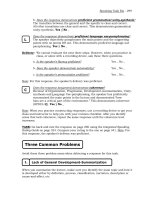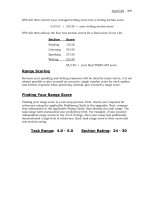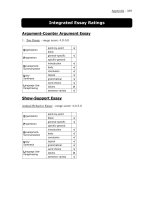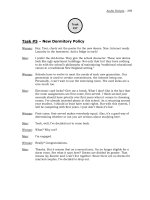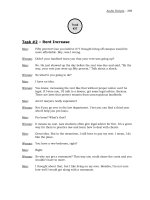Critical Reflections on the Vital Importance of Soft Skills and the Strategies for the Integration of Essential Soft Skills into the Curriculum of Highe Education Business Institutions in Vietnam (LV thạc sĩ)
Bạn đang xem bản rút gọn của tài liệu. Xem và tải ngay bản đầy đủ của tài liệu tại đây (2.3 MB, 324 trang )
Critical Reflections on the Vital Importance of Soft
Skills and the Strategies for the Integration
of Essential Soft Skills into the Curriculum of Higher
Education Business Institutions in Vietnam
By Hang Thi Thu Truong BA, Med
A dissertation submitted to the University of
Newcastle in partial fulfilment of the requirements
for the degree of Doctor of Philosophy
Faculty of Education and Arts
The University of Newcastle
October, 2016
ii
DECLARATION
I certify that this thesis does not, to the best of my knowledge and belief:
(i)
incorporate without acknowledgment any material previously
submitted for a degree or diploma in any institution of higher
education.
(ii)
contain any material previously published or written by another
person except where due reference is made in the text; or
(iii)
contain any defamatory material.
I give consent to the final version of my thesis being made available
worldwide when deposited in the University’s Digital Repository subject
to the provisions of the Copyright Act 1968.
14 October 2016
Hang Thi Thu Truong
iii
ACKNOWLEDGEMENTS
Taking up a PhD has taught me more about the essence of
interdependence in life than anything else could has taught me so far. No one
who writes a doctoral thesis stands or thinks alone. I have come to learn that
many things have to come together and are dependent on each other in order
to accomplish something in life.
In the context of the completion of this research work and thesis, I would
like to primarily express my gratefulness to my Principal Supervisor, Professor
Ron Laura, and my Co-supervisor, Dr. Kylie Shaw, for the profound insights,
visionary thinking, and innovative ideas with which they challenged me. My
sincere thanks to you both from the bottom of my heart for raising me up from
the local pond of my novice research to a seemingly endless sea of erudition
and hopefully ever increasing scholarly insight. I wish to thank both my
supervisors also for ensuring that our every meeting was invaluable, and I
always left feeling a lot better in my head and my heart than when I arrived.
Thank you both for your patience in treating me with respect, despite all the
silly questions I have asked. Even more incredible is the fact that you never
failed to answer them as lucidly as you could, thus bringing illumination to my
research reflections and helping me gradually to ask better questions more
worthy of your intellectual gifts. In turn my research capacity was greatly
enhanced, along with my appreciation of scholarly excellence for which I shall
always strive. I owe my deepest gratitude to both of you, for without your
guidance, encouragement and support, it would have been impossible for me
to do justice to my VIED scholarship office and bring pride to my family and
iv
friends by completing this thesis.
I would like to thank the Vietnamese government for the support it
provided through the Vietnam International Education Development-Ministry of
Education and Training, and The University of Newcastle, Australia, for
awarding me a VIED-TUIT scholarship to support my doctoral studies.
My thanks also to the University of Newcastle for providing such a rich
research environment with outstanding support services for its students. In
addition, I would like to thank other academics and professional staff of the
School of Education and the Faculty of Education and Arts, who have so
willingly assisted me with the many administrative matters that inevitably
arose.
I am also grateful for the participation of Vietnamese employers and
educators in this study. Thank you for finding the time and effort to share your
opinions with me, thus helping to bring this research project to completion.
I would also like express my great thankfulness to Mrs Hedy Fairbairn
who has supported me in my research methodology in my last candidature
year.
Eventually, I want to express my love and boundless gratitude to my
family who have always been there supporting me, both in terms of my
financial and mental wellbeing. To my lovely son, Tony Nguyen, I especially
owe you a debt of gratitude for your forgiving me for not being as present in
your life as I would have liked in this chaotically busy time. I hope you know
v
that every time I have ever seen you smile, in person and in my dreams, I feel
assured that no matter what happens, I know that I can succeed and that
everything is possible? Words cannot express the extent of my appreciation for
all that you have done for me in bringing such happiness to my life. I would
also like to express my gratitude for all of the support I have had from those
colleagues and friends who have constantly encouraged me in my studies.
vi
ABSTRACT
Investing in human capital is one of the most relevant factors affecting
the economic growth of a country, and one of the most important aspects of this
investment is education. Thus in developing countries such as Vietnam it is
imperative that the government supports policy priorities
committed to
strategies for creating a knowledgeable foundation for the development of a
skilled and adaptable workforce capable of contributing
to the goals of
business competitiveness at the local and especially the global level. Within
Vietnam's system of higher education, its schools of business do play a vital
role in supporting the country’s economic objectives. However, one of the major
objectives in this thesis is to show that the crucial contribution which soft skills
are capable of making to achieve maximal success within the business sector
has to date not been adequately recognized by its business schools. This being
so, the development of the business school curriculum in Vietnam has not been
able to 'catch up', so to say, with the requirements of local and global business
market. This being so, the central argument of my thesis is that in Vietnam there
is a burgeoning need to provide students with comprehensive soft skills
program designed to meet the national and global business standards
increasingly exhibited within the current objectives of their potential employers.
This being so, it is essential that the formal curriculum of Vietnam’s Business
schools be restructured to incorporate an up-to-date and effective coursework
component for the delivery and development of business soft skills.
To fulfil the requirements of curriculum reform, the thesis focuses on
three objectives. The first aim is to assess the status of soft skills proficiency
vii
possessed by tertiary business graduates, thereby revealing the presence and
quality of any soft skills programs in Vietnamese business higher education
institutions (BHEIs). The second purpose is two twofold: the first task is to make
explicit the extent to which major Vietnamese stakeholders acknowledge and
value the potential role which soft skill competencies can play in maximizing
business success. Through that, the second concern is to determine which
particular soft skills these stakeholders discern as best serving to improve
Vietnam's
economic
competitiveness
within
the
national
and
global
marketplace. The final aim of the study is devoted to identifying the most
efficacious strategies for the development of soft skills programs in Vietnamese
business schools.
A Sequential Exploratory Mixed-methods Approach was deployed in
which in the first phase, semi-structured telephone interviews were conducted,
with 15 business employers representing Vietnam's reputedly largest business
enterprises across Vietnam. In the second phase, a questionnaire was
conducted with 577 business educators from three major universities of
business, representing different regions of the country.
The study makes four main contributions: Firstly, this is the first
comprehensive exploration and collation of the literature exploring the definition
and importance of soft skills in the field of Business, thereby accumulating a
legacy of valuable information for employer and educational stakeholders in
Vietnam to better understand the status of soft skills in the local business
workplace and global market. Secondly, the results of the study identified the 19
essential soft skills for success selected by Vietnamese business employers
viii
which can be integrated into the formal business curriculum of business higher
education institutions. This contribution also serves as a benchmark skill
checklist for staff development and recruitment for employers. Thirdly, preferred
approaches to soft skills development were identified by employers and
business educators that are suitable for the current status of the country’s
higher education system, culture and economy. Finally, the findings indicate
that increased collaboration between educational institutions and business
enterprises in the development of soft skills for Vietnamese business schools is
more likely to result in accrued benefits to its economy. This has been achieved
by focusing on the development of the specific soft skills needed to increase the
employability of business graduates and upon a shared utilization of resources
to enhance the effectiveness of soft skills training.
In summary, this study represents a comprehensive investigation of
strategies for soft skills curriculum development which draws upon the
contributions of relevant key stakeholders, namely, those Vietnamese business
employers who are most likely to hire business school graduates, and the
university educators of business who are responsible for their soft skills training
in accord with the reformed curriculum of Vietnamese business schools. Thus,
the study bridges the hiatus between the soft skills competencies required by
Vietnamese employers on the one hand, and the adequate provision of soft
skills development programs by soft skills educators in Vietnam's higher
education business institutions. Findings from this study could be used
productively to inform and shape the nature of the curriculum reforms and
pedagogic interventions that need to be undertaken collaboratively by
ix
knowledgeable staff from both tertiary business universities and business
employment organisations
x
TABLE OF CONTENTS
DECLARATION .................................................................................................. iii
ACKNOWLEDGMENTS ..................................................................................... iv
ABSTRACT........................................................................................................ vii
TABLE OF CONTENTS ...................................................................................... xi
LIST OF TABLES ............................................................................................ xvii
LIST OF FIGURES ..........................................................................................xviii
LIST OF ABBREVIATIONS .............................................................................. xix
CHAPTER 1 INTRODUCTION ...........................................................................1
Introduction .................................................................................................1
Background to the Study .............................................................................4
Demographic Data.............................................................................4
Economy............................................................................................5
Tertiary Education .............................................................................9
The Roles of Ministry of Education and Training ...............10
Curriculum ..........................................................................11
Teaching Staff ....................................................................12
Teaching and Learning Activities .......................................13
Business Undergraduate/Tertiary Education...................................13
Soft Skills Education in Business Programs ......................15
Research Problem ....................................................................................17
Rational of the Study .................................................................................20
Focus of the Study ..........................................................................23
Aims of the Study ......................................................................................26
Research Questions ..................................................................................27
Significance of the Study ...........................................................................28
The Structure and Organization of the Thesis ..........................................31
Conclusion ................................................................................................34
xi
CHAPTER 2 LITERATURE REVIEW .................................................................36
Introduction ...............................................................................................36
Definition of Soft Skills ..............................................................................37
The Importance of Soft Skills ....................................................................41
The Importance of Soft Skills in Business Career Success ............41
The Importance of Soft Skills in Business Education ......................45
Curriculum Reform for Soft Skills Development ........................................49
A Need for Curriculum Reform ........................................................49
Collaboration of Educator and Employer .........................................54
Understanding of the Collaboration in Education ...............55
Effective Development of the Collaboration of Educator
and Employer .....................................................................60
Curriculum Reform ..........................................................................62
Integrating Soft Skills into the Curriculum ..........................62
Curriculum Integration and Concept-Based Curriculum .....67
Work Placement, Internship and Work-Based Learning ....70
Workplace Simulation in Classroom Settings ....................72
Training Source ..................................................................74
Soft Skills Development under Computechnological
Environment .......................................................................75
Conclusion ................................................................................................77
CHAPTER 3 RESEARCH DESIGN AND METHODS………………………...…80
Introduction ...............................................................................................80
Research Purpose and Questions ............................................................80
Research Methodology and Design ..........................................................83
Project Design………………………………………………………….83
Validation………………………….…………………………….88
Qualitative Phase ......................................................................................90
Research Participant ........................................................................90
Research Instrument ........................................................................93
xii
Designing Open-Ended Questions and SemiStructured Interview Schedule……………………………..95
Pilot ....................................................................................98
Data Collection Procedure ............................................................98
Data Analysis ..............................................................................100
Presentation of Results and Interpretation ..................................102
Quantitative Phase ..................................................................................102
Research Participant ...................................................................103
Instrument Development .............................................................105
Scale Description .............................................................110
Pilot Study .......................................................................111
Data Collection Procedure .........................................................113
Data Analysis .............................................................................113
Data Screening ..............................................................113
Missing Data ..................................................................114
Descriptive Statistics ......................................................114
One-way Analysis of Variance (ANOVA) ........................115
Independent Sample T-test ............................................116
Factor Analysis ...............................................................116
Reliability ........................................................................118
Summary of Data Analysis Techniques .........................119
Data Presentation and Interpretation .........................................120
Conclusion ..............................................................................................120
CHAPTER 4 QUALITATIVE ANALYSIS AND RESULTS .............................121
Introduction .............................................................................................121
Demographic Information ........................................................................122
Personal Profile of Employers .......................................................122
Profile of Enterprises .....................................................................123
Importance of Soft Skills .........................................................................124
Understanding about ‘Soft Skills’ ...................................................124
Importance of Specific Soft Skills in the Business Workplace .......125
xiii
Identification of Essential Soft Skills in the Business Workplace ..128
Equipping Graduates with Soft Skills for Employment ...........................135
Status of Business Graduates’ Employment .................................135
Status of Vietnamese System of Education and Training .............138
Approaches to Developing Soft Skills in the Workplace ................142
Strategies for Soft Skills Development in Universities ............................144
How to Identify Essential Soft Skills to be Taught .........................145
How to Integrated Soft Skills into the Curriculum ..........................147
How to Teach Soft Skills................................................................148
Who should Teach Soft Skills ........................................................150
Effects of Computechnological Environment on Soft Skills
Development .................................................................................150
Summary .................................................................................................152
CHAPTER 5 QUANTITATIVE ANALYSIS AND RESULTS ..........................156
Introduction .............................................................................................156
Demographic Information ........................................................................158
Site Description .............................................................................158
Respondent Rate ..........................................................................160
Missing Values Analysis ................................................................161
Respondent Demographics ...........................................................161
Gender................................................................................161
Qualification ........................................................................162
Discipline / Specialty ...........................................................163
Teaching Experience ..........................................................165
Descriptive Statistics – Soft Skills Training Information ...........................166
The Importance of Soft Skills ........................................................166
The Soft Skills Currently Taught ....................................................166
Soft Skills Teaching Experience ....................................................168
Preparedness for the Workplace ...................................................171
Revision of Curriculum for Soft Skills Development .....................171
Learning Environment: Factor Analysis and Scale
Development .................................................................................172
xiv
Importance of Specific Soft Skills ............................................................175
Demographic Influences: Specific Soft Skills ..........................................177
Location .........................................................................................177
Gender...........................................................................................179
Qualification ...................................................................................180
Discipline .......................................................................................181
Teaching Experience .....................................................................183
Soft Skills Teaching Experience ....................................................184
Strategies for the Development of Soft Skills ..........................................185
Soft Skills Integration .....................................................................186
Soft Skills Training Methods ..........................................................188
Effects of Soft Skills Development ................................................191
Demographic Influences: Soft Skills Development .................................192
Location .........................................................................................193
Gender...........................................................................................193
Qualification ...................................................................................194
Discipline .......................................................................................195
Teaching Experience .....................................................................195
Soft Skills Teaching Experience ....................................................196
Conclusion .............................................................................................196
CHAPTER 6 DISCUSSION ............................................................................199
Introduction .............................................................................................199
Status of Soft Skills in Vietnam ...............................................................199
Soft Skills Competency of Graduates in the Eyes of Employers ...199
Status of Soft Skills Education in Business Higher Education
Institutions .....................................................................................203
The Importance of Soft Skills ..................................................................207
The Importance of Soft Skills in Business .....................................207
The Essential Soft Skills ................................................................209
The Strategies for Soft Skills Development ............................................212
Soft Skills Identification .................................................................213
Soft Skills Integration .....................................................................214
Soft Skills Training Method ............................................................215
xv
Soft Skills Trainer ..........................................................................217
Conclusion .............................................................................................218
CHAPTER 7 CONCLUSION……………………………………………………...219
Introduction ............................................................................................219
Key Findings of the Study ......................................................................220
Key Outcomes of the Study ...................................................................224
Recommendations of the Study .............................................................225
Employers ...................................................................................225
Business Educators ....................................................................229
Government Policy Makers ..........................................................231
Limitations and Suggestions for Further Research ................................232
Conclusion .............................................................................................234
REFERENCES ................................................................................................237
APPENDICES ......................................................................................... 280
Appendix A: Ethics Approval – Phase One ............................................281
Appendix B: Ethics Approval – Phase Two .............................................282
Appendix C: Interview Protocol ...............................................................284
Appendix D: Survey Questionnaire ........................................................286
Appendix E: Invitation Letter to Employers .............................................292
Appendix F: Invitation Letter to Educators ..............................................293
Appendix G: Consent Form ....................................................................294
Appendix H: Demographic Data of Employers .......................................295
Appendix I: Project Information Statement ..............................................298
Appendix K: Reliability for Learning Environment Scale .........................301
Appendix L: Factor Analysis for Strategies Scales .................................302
xvi
LIST OF TABLES
Table 5.1: Questionnaire: Number Distributed and Response Rate by
Site……………………………………………………………………………160
Table 5.2: Gender – Frequency Distribution across Sites ........ ……..…..162
Table 5.3: Qualification – Frequency Distribution across Sites ...............163
Table 5.4: Discipline – Frequency Distribution ........................................164
Table 5.5: Teaching Experience - Frequency Distribution across Sites ..165
Table 5.6: Proportion of Program – Frequency Distribution across Sites167
Table 5.7: Soft Skills Current Taught across Sites ..................................170
Table 5.8: Learning Environment ............................................................173
Table 5.9: Learning Environment: Factor Loadings and Scale Statistics 174
Table 5.10: The Essential Soft Skills .......................................................176
Table 5.11: ANOVA: Soft Skills Importance by Location ........................178
Table 5.12: The Most Important Soft Skills by Site .................................179
Table 5.13: T-Test: Soft Skills Importance by Gender ...........................180
Table 5.14: ANOVA: Soft Skills Importance by Qualification ..................181
Table 5.15: ANOVA: Soft Skills Importance by Discipline .......................182
Table 5.16: The Most Important Soft Skills by Discipline .......................183
Table 5.17: T-Test: Soft Skills Importance by Experience ......................185
Table 5.18: Scale Characteristics ...........................................................186
Table 5.19: The Strategies for Soft Skills Integration ..............................187
Table 5.20: The Strategies for Soft Skills Training .................................189
Table 5.21: The Effects of Soft Skills Development ................................191
Table 5.22: ANOVA: Strategies for Soft Skills Development by Location194
xvii
LIST OF FIGURES
Figure 1.1: The Structure of the Thesis .....................................................32
Figure 2.1: The Greater Educational Achievement Response System .....59
Figure 3.1: Methodology of Sequential Exploratory Mixed-Method ..........87
Figure 3.2: Distribution of Respondents Across the Country ...................92
Figure 4.1: The Most Important Soft Skills Identified by Employers ........130
Figure 6.1: Rating of Soft Skills by Employers and Educators ...............210
xviii
LIST OF ABBREVIATIONS
BHEIs
Business Higher Education Institutions
BHES
Business Higher Education System
FDI
Foreign Direct Investment
HES
Higher Education System
HEIs
Higher Education Institutes
MOET
Ministry of Education and Training
SMEs
Small and Medium Enterprises
xix
CHAPTER ONE
INTRODUCTION
Introduction
Vietnam has been one of the best performing economies in the world
over the last decade (Nguyen et al., 2008; The World Bank, 2016). The process
of Vietnam’s integration into the world economic market, along with the
country’s advancements in industrialization and modernization, have increased
demands to improve and augment the productivity of the work force. This being
so, Vietnam, now at a crucial stage of its expansionary economic development,
assimilated 425,000 tertiary graduates into its workforce during the 2014-2015
academic year (TalkVietnam, n.d., para.5). The country is also faced with a
momentous challenge to provide highly qualified personnel for the emerging
modern sectors of the economy.
A particularly serious problem is that the
country’s higher education institutions (HEIs) are presently unable to equip the
students with the appropriate skills and knowledge needed to meet the
demands of rapidly increasing economic development. Although the number of
tertiary graduates has increased rapidly over recent years, there exists a
widening gap between the types of skills and level of expertise required by the
business sector on the one hand, and the absence of those same skills and
general low aptitude of business school graduates. This disparity has
1
exacerbated the current and acute dissatisfaction felt by employers when trying
to recruit appropriately trained graduates. This has meant jobs remain unfilled
and in parallel to this a tide of rising unemployment (Tran, 2006; Tran, 2013). As
a result, the number of university graduates unable to find a job has been
increasing exponentially in Vietnam and now accounts for one fifth of the
country’s unemployment (General Statistics Office, 2014). Pham (2013) found
that
two
thirds
of
potential
Vietnamese
employees
lack
work-ready
competencies, and the level of the work readiness of the remaining one third is
abysmal. Thus, a limitation in skills is considered to be one of the biggest
barriers preventing Vietnamese graduates smoothly transitioning from university
to the workplace (Tran, 2006; Tran & Swierczek, 2009). Interestingly, the skills
gap is not so much a deficiency in the technical or 'hard skills'. Rather, it is
claimed that one of the main reasons for the ill-prepared university graduates is
that their 'soft skills', or what might be called 'people skills' are weak or totally
absent (Pham, 2008; Tran & Swierczek, 2009). Many new Economics and
Business graduates cannot take up their positions after their recruitment
because their soft skills competency is far below what business employers
expect. It is 'soft skill incompetence', not 'hard skills inadequacy’ that
paradoxically jeopardizes business growth and has created such a significant
challenge for business development.
The cause of the problem is that the development of the soft skills
curriculum in Vietnamese Business Higher Education Institutions (BHEIs) in
Vietnam has not kept pace with the changing needs of the economy (Dennis &
Phan, 2005). BHEIs have failed to pay sufficient attention to equipping their
2
students with the requisite level of soft skill competency. Given the growing
awareness of employers regarding the quintessential role played by soft skills in
business success and in economic developmental, the government of Vietnam
has decided to initiate and implement one of three "breakthrough areas" in the
Socio-Economic Development Strategies 2011-2020 by redirecting human
resources towards the development of new working skills, particularly, the 'soft
skills' necessary to facilitate the rapid growth of modern industry and business
innovation (The World Bank, 2011; British Council, 2012). Curriculum
development in the business school sector is now acknowledged by the
government as a vital ingredient for improving the overall quality of higher
education. Cognisant of the increasing importance of curriculum development,
the government of Vietnam issued a document in 2004 (No.1269/CP-KG),
which assigned to leading HEIs the task of designing advanced curricular
innovations. The concept of 'advanced curricular innovations' refers to the
development of new curriculum directions which are properly designed to reflect
the curriculum reforms currently in place at the most prestigious universities in
the world. The new models of Vietnamese curriculum development are meant to
include important aspects of the subject content, teaching methods, and
organisational training and management processes of the world's leading
universities (Vietnamese Ministry of Education and Training, 2008, p.3)
The burden of the present thesis will focus on a particular aspect of this
curriculum development as it relates to ascertaining the extent to which the
acquisition of soft skills of a certain kind can make a significant difference to the
success of business interactions. Specifically, the study undertaken here will
critically examine the two salient foundational elements of soft skills resources
3
with the aim of defining the paramount role they play in the development of
innovative curriculum reform which targets the most effective strategies for the
integration of soft skills into the tertiary business school curriculum. This
introductory chapter describes the fundamental elements that give rise to the
research questions that define this doctoral research. The chapter elucidates
the place of soft skills education in Vietnamese BIEIs and outlines the research
problem.
Background to the Study
Demographic Data
Vietnam is a small agricultural country located easternmost on the
Indochina Peninsula in South East Asia. It covers a total area of approximately
331 212 square km. It has the third largest population in South East Asia and
is ranked the thirteenth largest population in the world with an estimated 95
million people in 2016 (Vietnam Population, n.d., para.1). Seventy percent of
the population lives in rural areas, while another 30% live in the two largest
urban cities in the country, virtually most of which live in the two largest cities,
Hanoi and Ho Chi Minh City (General Statistic Office, 2012b).
The official language of Vietnam is Vietnamese which is spoken by
86% of Vietnam's population. Vietnam is a country which has a reasonably
wide diversity of religions, though the statistics show that about 85% of
Vietnamese are Buddhists (Pham, 2008). The Socialist Republic of Vietnam is
a single-party state, the founding and ruling political party is the Communist
Party of Vietnam. This single party maintains government and has centralized
4
control over the state, military and media. Vietnam’s strengths are considered
to be its large market for goods and services, the effective functioning of its
labor market, and its high female labor force participation rate. Moreover,
Vietnam is well known for its global competitiveness based on its natural
resources and a workforce with proficient in the hard skills (World Economic
Forum, 2007).
Economy
Political and economic reforms known as ‘Doi Moi’ (‘Doi Moi’ means reform and
renovation), which were launched in 1986, have transformed Vietnam from one
of the poorest countries in the world to the one of the best performing
economies in the world over the last decade (Skaif, 2011) with an annual
growth rate of 5.3 percent – faster than any other Asian economy apart from
China (British Council, 2012).
The World Bank further stated, “Vietnam’s poverty reduction and
economic growth achievement in the last 15 years is one of the most
spectacular success stories in economic development” (Skaif, 2011). Doi Moi
had a significant and immediate impact on the economy that involved
privatizing agriculture. This was the time when property rights were also being
introduced, while price controls and controls on foreign trade were being eased
as Vietnam was re-engaging with the international economy (Glewwe, Agrawal,
& Dollar, 2004). One remarkable change in the economy after Doi Moi was the
development of a multi-sector economy. Before Doi Moi, there were only two
economic sectors in Vietnam, namely the state economic sector and the
5
cooperative economic sector. With an additional four sectors added after the
reform, the multi-sector economy allowed and encouraged private and foreign
investment organizations to develop their business in Vietnam (Nguyen, 2006).
Vietnam has experienced strong growth in both its private sectors and
foreign direct investment enterprises.
With its annual average Gross
Domestic Product (GDP) growth rate of 7.5%, since 2006 the economy clearly
enjoyed a relatively high growth rate compared to other developing countries
(Ministry of Planning and Investment, 2006). Along with the growth in GDP,
there has also been a significant change in the structure of the economy. With
more and more private and foreign direct investment enterprises the country is
now characterized by an increasing number of small and medium enterprises
(SMEs), with 87% of enterprises employing less than 50 employees and 57%
of enterprises employing less than 10 employees (General Statistics Office,
2008). “According to the Spring 2011 report, the number of Vietnamese SMEs
in 2011 was nearing 400,000, which represents 97-99% of the number of
businesses of the country, employed 77% of the workforce and accounted for
80% of the retail market” (Business in Asia, n.d., para. 3). However, in the
period of 2011-2015, the statistics showed that the total number of newly
established enterprises, of which the majority was SMEs, declined significantly
and steadily from 83,600 in 2010 to 77,500 in 2011 and 69,800 in 2012. There
was a positive financial indicator in 2013 when the number bounced back to
76,900 enterprises, but this number still remained below 2009 and 2010
figures. One main of the reasons for the decline was that SMEs were facing
barriers and problems in the quality of resources, including human resources
(Phan, 2015).
6

